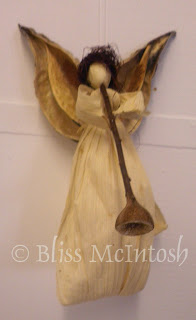This months local Wild Ones meeting on seasonal decorating with native plants promised the opportunity to create dried arrangements bringing the beauty of the prairie to our homes. Margaret Mary Gerhard, a former art teacher in the Howard-Suamico school district, has shared her passion for aesthetic recycling with thousands of students, colleagues, friends, and nonprofits. She challenges us to reconsider what we "throw away" as there really is no away. She encourages reusing, reducing and recycling, turning ordinary junk, we might typically discard, into creative works of art for a greener world.
 |
| Margaret Mary Gerhard The recycling dream lady |
Some of the "goods from the woods" she brought along to display that inspired me to gather dried materials for later craft projects before the snow starts to fly:
 |
| Red osier dogwood heart wreath |
 |
| Grapevine balls |
 |
| Painted stick snake |
 |
| Milkweed pod angel ornament |
 |
| Angel of milkweed pod and other natural materials |
 |
| Milkweed pod mouse |
 |
| Milkweed pod wreath |
 |
| Firestarters from pine cones in egg cartons |
 |
| Paint spattered over leaves with toothbrush |
 |
| Sock-covered vases |
 |
| Anise hyssop, lavender, and Russian sage |
 | ||
| Goldenrod, dried ferns, seedheads, and Harry Lauder's walking stick branches in a birchbark vase
|
Brooklyn florist Emily Thompson (whose clients include the White House) who went foraging for native plants to make 49 centerpieces for the Brooklyn Botanic Garden's 2013 spring gala offers the following tips for creating native floral arrangements:
* When you cut a native, put it immediately into water and keep it well hydrated.
* Choose natives for the shape and texture of their leaves.
* Use color sparingly.
* Create a support structure for your arrangement in the bottom of your vase or pot.
* Group natives that grow together in the wild; the result will look more natural.
* Start by creating a visual structure for the arrangement. Choose a primary plant material—one of the strongest plants you gathered, with a strong shape.
* Work with three materials only in each arrangement so you have "strong visual swaths."At the end, you can add a tiny visual punctuation of a fourth, colorful plant.
* Finding contrast is a goal. Pair a plant with a bigger leaf with something more delicate.
* Embrace the austerity of a single-color arrangement.
* Don't be afraid to work with plants with roots.

This one is woven using hand made string and features windows ,knotless netting and lacing. It took 9 sessions with around 3-5 people plus many other members contributed by making miles and miles of string.Trees-Plants Nursery
ReplyDelete